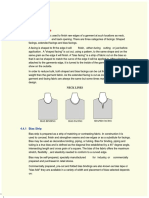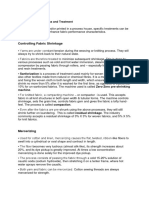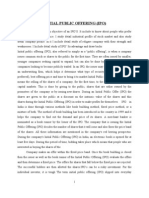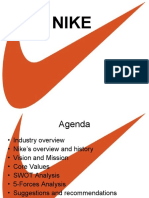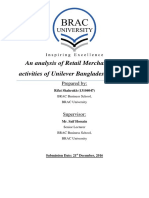Sleeves
Sleeves
Uploaded by
riteshbansal23Copyright:
Available Formats
Sleeves
Sleeves
Uploaded by
riteshbansal23Copyright
Available Formats
Share this document
Did you find this document useful?
Is this content inappropriate?
Copyright:
Available Formats
Sleeves
Sleeves
Uploaded by
riteshbansal23Copyright:
Available Formats
LESSON 10
SLEEVES
1.INTRODUCTION
These are a part of a garment which covers the arm of a body and are usually
attached to armhole of the bodice pattern. Todays garments are designed with a
variety of sleeves , which difer greatly in look and in method of construction. It is
possible to develop a variety of sleeve styles from the plain sleeve pattern. By
chossing a sleeve style that suits the fgure of wearer, design of the fabrics, design
of dress and current fashion, you can enhance the fashion of dress. ome sleeves
are designed to add width to the shoulder ! others are designed to minimi"e the
shoulder. #ll sleeves may be ftted or full at the wrist, and may be cut to any desired
lenghth. The instructions on making patterns for a variety of sleeve style are given
below$
2.CONTENTS
2.1 TERMINOLOGY
2.1.1Terminology use !or "#$$ern m#%ing
2.1.2 Terminology Use &or Me#suring
2.1.' Di(eren$ Slee)e Leng$*
2.2 +O, TO T-.E SLEEVE ME-SUREMENT
2.'CL-SSI&IC-TION O& SLEEVE
2.'.1 se$ in slee)e
2.'.2 slee)e /u$ 0i$* 1oi/e
2.2 TY3ES O& SLEEVE &INIS+
2.4 CU&&S
2.4.1 CU&&S ,IT+OUT 3l#/%e$
2.4.2 Cu(s ,i$* 3l#/%e$
2.1 TERMINOLOGY
2.1.1 Terminology use !or "#$$ern m#%ing
a% leeve cap& curved top of sleeve from front tpo back
b% 'ap height&distance from biscep to cap at the center
c% Biscep level&widest part of sleeve dividing cap from lower section of the
sleevs
d% 'ap case&diferences between cap and armhole measurement( ranging from
) to ) )*+ inches%
e% leeve ease&additional allowance at biceps ,elbow and wrist level
accomdating the circumferences of the arms and allowing eae for freedom of
movement.() , to - or more inches.%
f% .lbow level& the location of the long sleeve , level with wrist.
g% /rist level& the bottom of the long sleeve, level with wrist
h% 0rain line& center of the sleeve from top of the cap to wrist level 1straight
grain of sleeve.
i% 2otches& one notch indicates from sleeve and two notches indicate back
sleeve. 'ap notch indicates where sleeve and shoulder should meet
2.1.2TERMINOLOGY USED &IR ME-SURING
a% S*ouler line$ important matching line for sleeve . hould fall e3actly
on top of shoulder .divides front and back of bodice.
b% U""er #rm$ must contain su4cient ease to permit sleeve to hang
smoothly and for arm to move freely.
c% -rm*ole5 large enough not to blind to allow arm to move freely.
d% Lo0er #rm5 should ft comfortably, not too tight. 5arts or ease
stitching at elbow can provide shaping for more comfort and easier
movement.
e% Leng$*5 should be appropriate for garment design and individual
fgure proportions.
2.1.' Di(eren$ Slee)e Leng$*
C#"$ a very short sleeve ! almost an e3tension of the shoulder.
S*or$$ around midsection of upper arm below short sleeve line. Typical short
sleeve lies with its lower edge relatively short across the upper arm.
-1o)e6el1o05 slightly above the elbow
T*ree 7u#r$ers5 appro3imately three&fours the lenghth of the arm.
6re7uently half way b*w the three&7uarter and the long sleeve.
,ris$ leng$*5 comes to bone.
Long or !ull6 leng$*$ falls appro3imately , inches beyond wrist bone but
before reaching the hand.
2.2 +O, TO T-.E SLEEVE ME-SUREMENT
The measurement given for sleeve drafts are based upon the ideally proportioned
arm. They are result of research work done by patterns maker in the manufacturing
industry. The same method would be used to measure an individual.
6ig. shows the basic points fom which measurement are taken. These would be
established by making with chalk. They are namely$
#& shoulder tip point
B& armpit
'& inside wrist
5& back of wrist or little fnger position
. 1 elbow point(used particularly whenmeasuring individuals.%
/here 8easurement #re Taken
6ig. shows 9ust where measurement are taken. 2otice that you have two vertical
and hori"ontal measurements. These are all that are needed to produce the draft for
a standard si"e sleeve sloper.
). Overarm measurement$ taken from the shoulder tip point , over the elbow
point, and down to the back of the wrist or little fnger position. #rm should
be bent as illustrated.
-. Underarm measurement$ this measurement i:s taken fron the armpit to the
wrist, with the arm hanging naturally.
;. Biceps measurement$ taken in a position in line with the armpit. In standard
si"es two inches have been added to provide some ease<. /hen measuring
individuals the arm may be measured e3actly and then two inches added to
the literal biceps measurement.
<. Wrist measurement$ taken around the wrist e3actly over the wrist 9oint. =ne
inch is usually added to the e3act wrist measurement to provide normal ease.
2.' CL-SSI&IC-TION O& SLEEVE
There are two ma9or classifcation of sleeve$
2.'.1 se$ in slee)e is cut separately and stitched into the armhole of the bodice
smoothly or with gathers. They can have any fullness and can be cut to any length.
S$r#ig*$ slee)e5 a sleeve which is very basic and can be used for development of
the styli"ed sleeves.
S*ir$ slee)e5 this sleeve is developed from straight sleeve. This wrist level is
modifed to provide su4cient elbow room for the arm when bent and a slit is
provided for hand entry. The hemline which is attached to the cuf may be
gathered , pleated or tapered into the cuf of any desired width.
C#" slee)e5 a very short set in sleeve which may be either 9ust away from the arm
of ft the arm snugly. This is usually designed for bodice dresses or blouses.
3e$#l slee)e5 such a pretty sleeve design that looks like a tulip over your shoulder.
This styles suits any arm shapes and si"es.
8ell slee)e5 this sleeve is narrow at the shoulder and gets wider towards the end
,creating a bell like shape& much the same as the way bell bottomed >ares do. It can
be long or short stopping at the arm , the elbow , or the wrist. ?ersatile and
>attering@
3u( slee)e5it is short set&in&sleeve which is gathered either at the armhole or at
the cuf or both is controlled at base by a cuf or elastication to give a pufed efect.
L#n$ern slee)e5 a long*short set&in&sleeve constructed in two parts. The top part
>ares slightly from the sleeve heads towards the wrist. The bottom part >ares from
a >irting wrist to meet the >ares of the top . both are seamed together
8is*o" slee)e5 a long full sleeve which >arers out at hemline which is shirred
,pleated, tucked, or darted into a cuf, binding or elastic, giving it a blousan efect.
It can also have a greater access in back than in front and additional length in
hemline for blousing.
Leg6o mu$$on slee)e5 a sleeve that is e3tremely wide over the upper arm and
narrow from the elbow to the wrist.
+#n%er/*ie! slee)e5 sleeve made with the s7uare pieces put over the shoulder
in such a manner that it falls in point like handkerchief.
,eing slee)e5 the traditional long buttoned wedding sleeve is based on basic
sleeve with elbow dsrt transferred to the hemline.
Co0l slee)e5 drapes from the center of the sleeve cap to any desired depth.
2.2.' Slee)e Cu$ ,i$* - 3#r$ Or T*e En$ire 8oi/e
Dro""e s*ouler5 the shoulder is e3tended and shaped around the shoulder
rather like the cap sleeve.
R#gl#n slee)e5the sleeve is combined with part of bodice armhole and shoulder
area.
S#le slee)e$ variation of raglan sleeve which the shoulder portion from a
straight band cut in one piece with sleeve and seamed to front and back parallel to
shoulder, instead of at an angle in raglan style.
.imono slee)e5 a long sleeve that is complete e3tension of the bodice to wrist.
The seam lines are along the top of sleeve and at the underarm. This sleeve is
derived from the 'hinese historic garment.
Dolm#n slee)e5 it is a sleeve with lowered armhole. The shoulder e3tends through
top of the sleeve and the underarm seam follows from the side of the bodice
through to the wrist. It has deep under seams with e3aggerated folds underarms,
providing for high arm lift. It is developed from kimono sleeve.
9ulie$ slee)e5 a long , tight sleeve with a puf at the top , inspired by fashions of
the Italian Aenaissance and named after shakespeares tragic heroine! popular from
the empire period through the )+-Bs in fashion.
2.2 TY3ES O& SLEEVE &INIS+ES
The fnishing of sleeve edge usually depends on the pattern design. It may be a
sinCmple self&hem or faced fnish(shaped or bias% or decorative double binding
made from self or contrasting fabric. The fnish is sometimes attached with casing
or with cuf. 6or successful completion of any sleeve, follow the general guidelines
as below$
). 8ark hemline to a length becoming to the wearer.
-. Dractice good pressing techni7ues throughout the fnishing process.
;. Aeduce bulk wherever possible.
2.4 CU&&
'uf are fabric bands at the bottom of straight, gathered or pleated sleeve edges.
#lthough cuf styles arer varying according to the garment design, any cuf will
basically be one of the two general types. The frst type cuf without placket can be
used on both long and short sleeve, and is made large enough around for the hand
or arm to slip in end out easily without a cuf&and&placket opening. The second type
cuf with placket of cuf is generally attached to a long sleeve and, diferent from
the frst type, re7uires a cuf&and&placket opening fastened snugly around wrist
2.4.1 Cu(s ,i$*ou$ 3l#/%e$s
Because 'ufs /ithout Dlackets have no openings . they are cut large so the hand or
arm can slip easily in and out. There are three basic styles of this cuf type. The
straight band cuf, straight turn back cuf, shaped turn back cuf. . The straight band
cuf is made with a seprate cuf attached to sleeve bottom. The straight turn back
cuf is made by turning the deep fnshed hem of a sleeve. ometime, instead of the
deep self&hem, a seprate e3tension piece is added to the sleeve bottom to form the
turn back cuf. The shaped turn back cuf that is separately constructed cuf that is
attached to the sleeve with a facing.
2.4.2 Cu(s ,i$* 3l#/%e$s
The three most popular styles are the lapped cuf, shirt cuf, and 6rench cuf. .ach is
constructed and applied to the sleeve after the placket opening is made at the
sleeve edge. The three most commonly used plackets , are the faced placket,
contiuous bound placket , and tailored or shirt placket. 2ote that edges of the faced
placket , meet at the opening , while edges of other two placket lap. The continuous
bound placket is fnished with a single fabric srip to create a narrow lap! the shirt
placket is fnished with two separate piece to create a wider gap. The lapped cuf,
with a continuous bound plackethas one end pro9ecting from placket edge.the shirt
cuf is sewed with its ends aligned to the under lap and overlap edges of the shirt
placket. The 6rench cuf, with a faced placket , is sewed to the placket edges so cuf
ends meet rather than lap. The cuf is cut wide to diuble back onto itself.
You might also like
- Sales InvoiceDocument1 pageSales InvoiceAileenNo ratings yet
- Clique Pens The Writing Division of U.S. Home Case Study #1Document2 pagesClique Pens The Writing Division of U.S. Home Case Study #1Jamil Huseynli0% (1)
- CPFR CourseDocument61 pagesCPFR CourseJulioEspinoza100% (1)
- (Tsan-Ming Choi, T. C. Edwin Cheng (Eds.) ) Sustain PDFDocument202 pages(Tsan-Ming Choi, T. C. Edwin Cheng (Eds.) ) Sustain PDFDian PriankaNo ratings yet
- Differentiation Strategies of Brioni, Louis Vuitton, and Giorgio ArmaniDocument12 pagesDifferentiation Strategies of Brioni, Louis Vuitton, and Giorgio ArmaniReader100% (4)
- Draping Technology B. Voc NotesDocument18 pagesDraping Technology B. Voc NotesKiruba Femi100% (1)
- Teach Yourself Stitch Craft and Dressmaking Volume IV: Pattern Drafting for Men and Practice Drafts - Trying your hand at drafting shirtsFrom EverandTeach Yourself Stitch Craft and Dressmaking Volume IV: Pattern Drafting for Men and Practice Drafts - Trying your hand at drafting shirtsNo ratings yet
- Smocking and Advanced Smocking MachineDocument16 pagesSmocking and Advanced Smocking MachineSalman SiamNo ratings yet
- 3-1 Derivatives of Elementary WeavesDocument20 pages3-1 Derivatives of Elementary WeavesRajesh DwivediNo ratings yet
- Properties Natural FibresDocument46 pagesProperties Natural FibresanishaNo ratings yet
- Spacer FabricDocument6 pagesSpacer FabricAnonymous 1pZlqV100% (1)
- Fabric and Garment FinishingDocument33 pagesFabric and Garment FinishingSurya Bakshi100% (4)
- GathersDocument12 pagesGathersNadia HammondNo ratings yet
- Featureso of Different Weaves 13.10Document28 pagesFeatureso of Different Weaves 13.10Atik U BhuiyanNo ratings yet
- Textile Design Lecture 2Document10 pagesTextile Design Lecture 2Muhammad Usama WaseemNo ratings yet
- 03 - Pattern MakingDocument40 pages03 - Pattern Makingmaya_muthNo ratings yet
- Constructing A Bifurcated Garment Trousers and ShortsDocument17 pagesConstructing A Bifurcated Garment Trousers and ShortsShubham SahNo ratings yet
- PlacketsDocument22 pagesPlacketsDivyanshi GoelNo ratings yet
- Neck FinishingDocument7 pagesNeck FinishingShresha DasNo ratings yet
- Lab Manual: Course Title: Apparel Manufacturing IV (Lab) Course Code: TE-428 Level and Term: L TDocument45 pagesLab Manual: Course Title: Apparel Manufacturing IV (Lab) Course Code: TE-428 Level and Term: L TMD OHiNo ratings yet
- Post Independence IndiaDocument3 pagesPost Independence IndiaPratima GhegadeNo ratings yet
- Resist DyeingDocument30 pagesResist DyeingĂĺëx KìñģNo ratings yet
- Fibres To FabricDocument23 pagesFibres To FabricPallavi Luthra Kapoor100% (1)
- Major and Minor Cellulosic FibresDocument127 pagesMajor and Minor Cellulosic Fibresnikitanath2367% (3)
- CountDocument15 pagesCountrezowan555No ratings yet
- Identification of Warp and Weft of A FabricDocument1 pageIdentification of Warp and Weft of A Fabricmaninarayan100% (2)
- Chemical Spinning: - Wet Spinning - Dry Spinning - Melt SpinningDocument5 pagesChemical Spinning: - Wet Spinning - Dry Spinning - Melt SpinningGolam SarwarNo ratings yet
- Commercial PatternDocument11 pagesCommercial PatternShantejah MitchellNo ratings yet
- Introd TextileDocument25 pagesIntrod TextileNila Kumar Singha100% (1)
- Experiment No: Experiment Name: - : 06 Study On Making A Pattern of TrouserDocument5 pagesExperiment No: Experiment Name: - : 06 Study On Making A Pattern of TrouserFaysal Ahmed RashedNo ratings yet
- Fabric Manufacturing StepsDocument15 pagesFabric Manufacturing StepsFazlul AzimNo ratings yet
- We Are The Leaders in Knitted Fabrics of All Kinds in The Sub ContinentDocument6 pagesWe Are The Leaders in Knitted Fabrics of All Kinds in The Sub ContinentMansoor KhanaliNo ratings yet
- Introduction To WeavingDocument17 pagesIntroduction To WeavingJahaziNo ratings yet
- Stitch TypesDocument21 pagesStitch TypesAjaz777100% (2)
- Agrotextiles - Study Material - 8th Semester BTech - 2023Document27 pagesAgrotextiles - Study Material - 8th Semester BTech - 2023Sanju100% (1)
- Basic Textiles StudyDocument2 pagesBasic Textiles StudyMaria ElizabethNo ratings yet
- Fabric StudiesDocument16 pagesFabric StudiesSrinivas DekondaNo ratings yet
- Commonly Used Finishing Methods On FabricsDocument4 pagesCommonly Used Finishing Methods On FabricsRajesh Dwivedi100% (1)
- Easy-Care and Durable Press Finishes of CellulosicsDocument11 pagesEasy-Care and Durable Press Finishes of CellulosicsGokul Raj KNo ratings yet
- FinishesDocument75 pagesFinishesShubham Tilara100% (1)
- Textile ScienceDocument6 pagesTextile ScienceJanah SevillaNo ratings yet
- Textile Design-3Document64 pagesTextile Design-3Nitin Verma100% (1)
- Structure and Design Final AssDocument20 pagesStructure and Design Final Assmike workuNo ratings yet
- TextileDocument85 pagesTextileGihan Rangana100% (1)
- Textiles - DiplomaDocument9 pagesTextiles - DiplomamansiagrawalNo ratings yet
- Cut & Sew, FullyFashionDocument3 pagesCut & Sew, FullyFashionmohammadirfan9889846100% (1)
- 161, Group 1, ThesisDocument9 pages161, Group 1, ThesisJahid HasanNo ratings yet
- Sewing ThreadDocument11 pagesSewing Threadmoorthy-sweetyNo ratings yet
- Sewing TermsDocument2 pagesSewing Termsmichutty100% (1)
- Functional FinishingDocument31 pagesFunctional Finishingsujal jhaNo ratings yet
- Textile ScienceDocument22 pagesTextile ScienceAbhinav VermaNo ratings yet
- Fabric Finishing Process and TreatmentDocument5 pagesFabric Finishing Process and TreatmentSwarnim DobwalNo ratings yet
- Interlining in ApparelsDocument13 pagesInterlining in ApparelssmitharaoNo ratings yet
- WoolDocument69 pagesWoolnitishkohli100% (5)
- Cut & Sew Knit WearDocument4 pagesCut & Sew Knit WearshponNo ratings yet
- Fabric Science-Ii: Subject Code: 17UTF09Document111 pagesFabric Science-Ii: Subject Code: 17UTF09Sweatha S100% (1)
- Sewing ProbDocument18 pagesSewing ProbAminur RahmanNo ratings yet
- Dimensional Changes of Fabric After Home LaunderingDocument10 pagesDimensional Changes of Fabric After Home LaunderingIshitta JainNo ratings yet
- MCQDocument8 pagesMCQsupriyadhage100% (1)
- A Brief Introduction To Fabrics: ImpulseDocument44 pagesA Brief Introduction To Fabrics: ImpulseAniket MaheshwariNo ratings yet
- Teach Yourself Stitch Craft and Dressmaking Volume V: Introduction to Sleeves and Collars - Drafting Patterns for Stitching Sleeves and CollarsFrom EverandTeach Yourself Stitch Craft and Dressmaking Volume V: Introduction to Sleeves and Collars - Drafting Patterns for Stitching Sleeves and CollarsNo ratings yet
- Seam Finishes 2Document8 pagesSeam Finishes 2riteshbansal23100% (1)
- Hand Sewing LessonsDocument81 pagesHand Sewing Lessonsriteshbansal23100% (2)
- Internatioanl Marketing EnvironmentDocument24 pagesInternatioanl Marketing Environmentriteshbansal23No ratings yet
- Initial Public Offering (Ipo)Document67 pagesInitial Public Offering (Ipo)riteshbansal23No ratings yet
- Manish Rai Research Paper - RevisedDocument14 pagesManish Rai Research Paper - RevisedJaya RaiNo ratings yet
- Gate Pass Report-Ctl-Gp-1078-23Document1 pageGate Pass Report-Ctl-Gp-1078-23Ahmed ShahNo ratings yet
- Cake Craft and Decoration - December 2014Document84 pagesCake Craft and Decoration - December 2014Iva Jelić StanojevićNo ratings yet
- Diccionario TextilDocument220 pagesDiccionario TextilJean Gutierrez0% (1)
- Arx BrochureDocument7 pagesArx BrochureIbrahim SahinNo ratings yet
- Kering - Luxury in The Digital World - Rania Ghannoum PDFDocument5 pagesKering - Luxury in The Digital World - Rania Ghannoum PDFRanda GhannoumNo ratings yet
- 3-4.7, N.ratna KishorDocument9 pages3-4.7, N.ratna KishorPrashant KhatriNo ratings yet
- JAYA Logitrans Services: Bill of LadingDocument3 pagesJAYA Logitrans Services: Bill of LadingMichael Tanjaya100% (1)
- BS BuzzDocument8 pagesBS BuzzBS Central, Inc. "The Buzz"No ratings yet
- Nutr681 Jan12 SyllabusDocument5 pagesNutr681 Jan12 Syllabusapi-96990759No ratings yet
- DR - Pepper FinalDocument16 pagesDR - Pepper FinalSiddharth BothraNo ratings yet
- Bar MenuDocument2 pagesBar MenureceptionhallsNo ratings yet
- FirstcryDocument22 pagesFirstcrypawan tiwariNo ratings yet
- Qyresearch Report: Skype Mango - Yang Phone: 8883654458 or +86-20-8665 5165Document6 pagesQyresearch Report: Skype Mango - Yang Phone: 8883654458 or +86-20-8665 5165api-282708578No ratings yet
- Amigurumi FreeDocument71 pagesAmigurumi FreeAlice WCM100% (3)
- Soal Ukk Kelas Vii 2013 Bahasa Inggris SMPN 1 Sumobito-KhitdhysDocument8 pagesSoal Ukk Kelas Vii 2013 Bahasa Inggris SMPN 1 Sumobito-KhitdhysYUNI HARTONO KHITDHYS100% (13)
- Lesson 1Document26 pagesLesson 1ravi_nyse100% (1)
- Econ11 09 Handout4 PDFDocument23 pagesEcon11 09 Handout4 PDFAshley BobNo ratings yet
- Nike's CaseDocument35 pagesNike's CaseSundeep PalNo ratings yet
- Unilever Merchandising PDFDocument37 pagesUnilever Merchandising PDFFerdoush Saleheen SupplychainclubNo ratings yet
- Noble Indonesia Company Profile 2020Document16 pagesNoble Indonesia Company Profile 2020Dedi RosandiNo ratings yet
- Allan Kaprow - New EssaysDocument18 pagesAllan Kaprow - New EssaysdijaforaNo ratings yet
- Garrett Wirtas ResumeDocument2 pagesGarrett Wirtas Resumeapi-312574839No ratings yet
- Project Procurement Management Plan (PPMP) 2021: END-USER/UNIT: Fisheries Post-Harvest and Marketing DivisionDocument58 pagesProject Procurement Management Plan (PPMP) 2021: END-USER/UNIT: Fisheries Post-Harvest and Marketing DivisionJhong GalsNo ratings yet


















